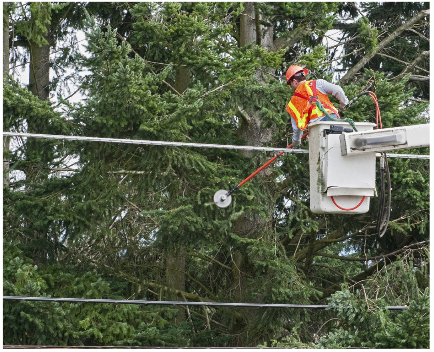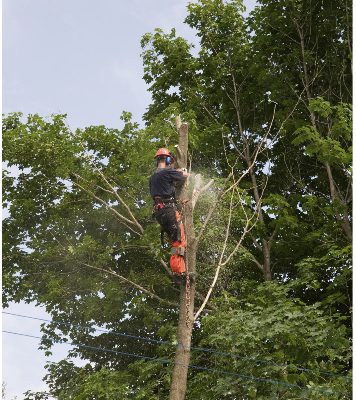 Safety Involves Everyone
Safety Involves Everyone
Do your part to keep you and your coworkers safe during tree-trimming activities:
- Attend all training so you can recognize, control, and avoid hazards.
- Report unsafe actions, conditions, and equipment.
- Think about what you’re doing and what others are doing around you.
Prevent Tree-trimming Related Injuries
In the tree-trimming industry, the risk of injury from lacerations, “struck-by” incidents, strains, slips and falls, and electrocutions is present every day on the job. These injuries can cause disability and days away from work. In some cases, they can be fatal. Many tree-trimming-related injuries can be prevented, if you follow the recommendations contained in this guide.
Lacerations are one of the most common injuries to tree trimmers. Tree branches and limbs, inadequate personal protective equipment, working carelessly or taking shortcuts are primary causes for lacerations. Lacerations can also result from the improper use of a tool or chainsaw.
Preventing Lacerations
Protect yourself against laceration injuries by wearing personal protective equipment including a hard hat, gloves, goggles, chaps (metal guards that cover the legs), and steel-toed boots.
- Inspect your cutting tool or chainsaw to insure that it’s sharp and functioning properly; a sharp tool is lees likely to slip and cause an injury.
- Hold your chainsaw with two hands, stand to the side of its cutting path, and be on guard for ricocheting limbs or chainsaw kickbacks.
- Work slowly; cut branches, limbs or logs below shoulder height and in a downward path.
- Carry your chainsaw below your waist level, with the engine off, and with the guide bar pointed down and to the rear.
“Struck-by” injuries occur when something hits you. You can be struck by ricocheting branches or by falling limbs, trees or equipment. You can also be struck by flying debris from chippers, grinders, and stumps.
Preventing “Struck-By” Injuries
- Protect yourself from “struck” injuries by wearing personal protective equipment including a hard hat, gloves, goggles or face shields, chaps, and steel-toed boots.
- Survey your surroundings, including workers nearby or below you who may need to be alerted to the consequences of your actions or movements.
- Remain on guard for ricocheting limbs or chainsaw kickbacks.
- Stand to the side of the chipper when feeding it.
- Clear debris off of and around stumps before making a cut.
- Stay out from under moving overhead loads or trimming operations.
Strains can occur when you work in awkward positions or when you handle heavy materials like tree stumps, branches or equipment. Repetitive work and vibrating tools can also lead to strains.
Preventing Strains
- Stay in shape. When your body is in good physical condition, you’re less likely to suffer a strain injury.
- Keep the work activity as close to your waist level as possible; avoid over-reaching and awkward positions.
- Lift only what you can safely manage, following recommended lifting techniques. For heavy loads, get help from another worker or mechanical lifting device.
- Choose tools that are comfortable for you to use; store materials and equipment that can be easily accessed.
- Rotate physical activities and take periodic breaks when fatigued.
Slips and falls can happen for a variety of reasons. Slips occur when there’s too little friction between your footwear and the walking surface. A slip can result if you wear improper footwear or if you walk carelessly on a wet, slick or unstable surface. Falls happen when your body is unable to maintain its center of gravity. Overreaching can cause you to fall, especially while working in an aerial lift. You can also fall if you use a makeshift support or set your ladder on uneven ground. Improper, damaged or worn fall arrest equipment can also result in a fall.
Preventing Slips and Falls
- Wear recommended footwear with appropriate soles and treads.
- Watch where you’re walking; walk carefully and deliberately.
- Maintain your balance and center of gravity; avoid overreaching.
- Conduct a safety check of tree-climbing equipment, ladders, and aerial lifts before use. Make sure that rope snaps are the locking type with at least 5000 pounds of minimum breaking strength.
- Insure that climbing equipment is placed on even, solid ground or is properly attached to recommended surfaces.
- Make sure you’re secured and stable when climbing or cutting and that your cut will not severe your fall arrest system.
Electrocution is a risk to tree-trimmers who work around utility lines and for workers who use electrical tools and lifts. Workers can also receive electrical shocks from ungrounded equipment or when using electrical equipment in wet or damp conditions.
 Preventing Electrocutions
Preventing Electrocutions
- Conduct a site survey before beginning work to locate power lines; assume all power lines are energized.
- Assure that equipment and workers maintain minimum required clearances from power lines; install a ground spotter or signal person to safety direct activities.
- Use caution when moving aerial equipment across uneven ground or in high wind conditions that could cause equipment to sway into power lines.
- Use only insulated and grounded electrical tools and equipment.
- Avoid wet or damp situations when using electrical tools and equipment.
